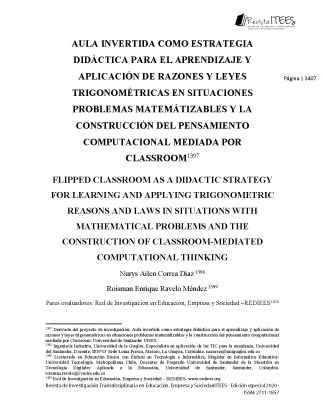CLXXX. FLIPPED CLASSROOM AS A DIDACTIC STRATEGY FOR LEARNING AND APPLYING TRIGONOMETRIC REASONS AND LAWS IN SITUATIONS WITH MATHEMATICAL PROBLEMS AND THE CONSTRUCTION OF CLASSROOM-MEDIATED COMPUTATIONAL THINKING
##plugins.themes.bootstrap3.article.main##
Abstract
The research aims to implement the flipped classroom method as a didactic strategy for
learning and applying trigonometric reasons and laws in situations of mathematical problems
and the construction of computational thinking through Classroom as a virtual classroom in
students of the tenth grade of IE No. 15 in the municipality of Maicao, with the purpose of
setting the teaching and learning process and improving results in internal and external tests.
The implemented methodology is quantitative, with a quasi-experimental design and
correlational scope when trying to determine the influence of a didactic strategy in the
learning of an area of knowledge, it has an explanatory value when showing the relationship
between two concepts. The study had two work groups, one of control and another
experimental one, this last one submitted to interventions of the inverted classroom approach,
allowing to collect information and to compare it with a control group.
The results obtained allow us to conclude that the implementation of the inverted classroom
approach promotes reflection and the generation of critical positions and the development of
written algorithms in the face of mathematical problems, since it encourages a discussion
environment that facilitates collaborative learning after individual work, while it shows a
high degree of motivation, good attitude, and willingness to work.
Download Statistics
##plugins.themes.bootstrap3.article.details##
flipped classroom, math, computer thinking, trigonometry
razones trigonométricas de ángulos coterminales cuadrantales del área de matemática
y estudiantes preuniversitarios de la Institución Educativa Privada Los Andes –2018.
Tesis para optar el título de Maestro en Educación con Mención en Docencia en
Educación Superior, Escuela de Posgrado, Universidad Continental, Huancayo, Perú.
Armijos Vásquez, I. G. (2018). Enseñanza de sistemas de ecuaciones lineales con dos
incógnitas utilizando el método de aula invertida en el décimo año de la unidad
educativa replica “Nicolás Infante Díaz” del cantón Quevedo (Master's thesis,
Universidad Nacional de Educación).
Bergmann, J., & Sams, A. (2012). Flip your classroom: Reach every student in every class
every day.Eugene, Or: International Society for Technology in Education.
Cuesta y Herrero (2010). Introducción al muestreo. Depto. de Psicología, Universidad de
Oviedo. Recuperado de: http://www.psico.uniovi.es/Dpto_Psicologia/metodos/tutor
Díaz, A. (2018). El método de aula invertida en educación media y sus efectos sobre el
desempeño en la competencia de la resolución de problemas en contextos
matemáticos. (Tesis de Maestría). Universidad de Antioquia, Medellín
Ministerio de Educación Nacional. (2006). Estándares Básicos de Competencias. Bogotá:
Imprenta Nacional de Colombia.
Mosquera Cucalon, W. (2015). Diseño de una propuesta didáctica para la enseñanza de
sistema de dos ecuaciones lineales con dos incógnitas utilizando el método “Flipped
Classroom” o aula invertida. Estudio de caso en el grado noveno de la Institución
Educativa Guadalupe del municipio de Medellín (Doctoral dissertation, Tesis
Doctoral. Universidad Nacional de Colombia-Sede Medellín).
Pérez y Ramírez, (agosto 2011) Estrategias de enseñanza de la resolución de problemas
matemáticos. Fundamentos teóricos y metodológicos. Revista de investigación. Nº
73. Volumen 35, p.175





